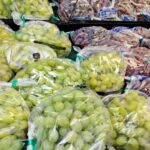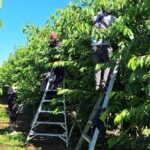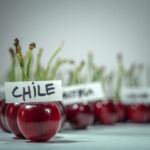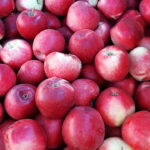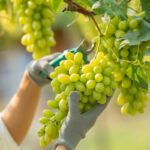Gold kiwifruit shortage window an opportunity for Chilean growers, says T&G
After Zespri Gold plantations were wiped out by verticillium a few years ago, many Chilean growers will be apprehensive to embrace a new gold kiwifruit variety, but Enza Gold has so far proven more resistant to Psa-V disease in New Zealand. Turners & Growers CEO Jeff Wesley says it still needs to be shown whether Enza Gold will hold up against verticillium in Chile, but expects 15,000-20,000 trays of the fruit to be exported this season from the South American country. In a recent visit to Santiago, he discussed the changes in store for Chile with both gold and red Enza varieties, and the need to get a grip on the early season 'cowboys' who have damaged its reputation in the past.
The Chilean kiwifruit industry is set to record a 7% rise in kiwifruit exports this year according to market researcher iQonsulting, but the country is still dominated by the green Hayward variety.
Wesley says the gold kiwifruit crop is still not very large but that is set to change in the coming years, especially as Zespri Gold production in New Zealand is on the decline and replacement variety G3 is yet to be confirmed, with years still in the pipeline for significant production if it is.
"The purpose of this visit was to basically catch up with growers who already have Enza Gold, it's all very new. There are plenty of plantings, I've seen those and they're very healthy - in two years time there will be quite a big crop
"Zespri produces about 100,000 trays of kiwifruit, of which about 20,000-30,000 have been Zespri Gold, but it looks at this point that in two to three years time there won’t be any Zespri Gold left anywhere, they’ll be finished.
"So there's a big window where the customers will be looking for gold product so we may accelerate those plantings; it’s a big opportunity for Chile, and it’s a big opportunity for growers everywhere really."
Wesley says Zespri Gold has a "fantastic taste" but it is understood G3 is not quite the same, while the Enza Gold is also different with mango overtones and a creamy texture.
"We have done trials on Enza Gold here (Chile) for verticillium so Zespri, I imagine are also trialling verticillium as well as Psa on G3," he says.
"G3 is a very new product. We've been working with Enza Gold since 2000, so that’s 12 years of experience; I think Zespri probably only got one or two years' experience with G3.
"I think there will be a window of three to five years there for gold kiwifruit that’s not Zespri branded."
Comparative benefits to green
Wesley highlights that Chilean green kiwifruit growers are in a very different situation to their New Zealand counterparts when it comes to profitability, and this - along with the Zespri Gold verticillium history - will have an effect on the take-up of Enza Gold.
 "Despite the strong Chilean peso, green growers here still make a reasonable income, even though the amount they’ve got over the years because of the exchange rate has become less," he says.
"Despite the strong Chilean peso, green growers here still make a reasonable income, even though the amount they’ve got over the years because of the exchange rate has become less," he says.
"They're still making a profit with green Hayward kiwifruit; that’s not the case in New Zealand for the vast majority of growers.
"A lot of them will keep the green, as if you’re making money on green you don’t want to suddenly take the orchard out and put a new orchard in. I believe some of the bigger growers who are already planting Enza Gold and in the winter will be planting red, will go through a few years and then the green growers will look and think that’s good - no verticillium problem and resistant to Psa (virulent strain), if it arrives."
He says the growing and marketing qualities of Enza Gold have more profitable prospects than Chile's Haywards, while it is also higher yielding than main Chilean gold variety Jingold.
"You have to remember that with Gold chinensis kiwifruit you get almost double the production compared to Hayward, and often 60% more in the price per kilogram, so in other words you’re almost four times ahead if you can grow good gold kiwifruit.
"We think Jingold, which is another gold kiwifruit, appears to have very low production with 20,000-25,000 (metric) tons per hectare, whereas Enza Gold is a very prolific kiwifruit and we think in the same circumstances there will be 50,000-60,000 (metric) tons per hectare.
"With Jingold there’s about 500 hectares planted so we’ll see over time about 500 hectares or more of Enza Gold."
Wesley adds that the pruning costs for Enza Gold appears to be significantly lower than for Zespri Gold.
Enza Red
Another alternative for Chilean growers is the Enza Red variety, otherwise known as RS1.
"The Sichuan Institute worked for years, keeping improving the quality to a commercial level of the red kiwifruit - it's stable, it's got a good size, it’s quite easy to grow and it has a fantastic taste," he says.
"There’s no Enza Red at the moment (in Chile). Enza Red will be planted in big volumes this coming winter and we probably will plant over a period of two or three years around 200 hectares.
As with Enza Gold, the Enza Red variety is still not able to be exported from New Zealand as it was rejected by Zespri, but Wesley is optimistic for its prospects in Chile given the growing conditions.
"Zespri will run around saying we should test it here, we should test it there, but we have all the supermarkets knocking on our doors asking ‘when can we have it?’ and it’s the same with Enza Gold," he says.
"You (Chile) have a Mediterranean climate, virtually no wind and in the growing season there’s virtually no rain, and Psa loves rain. So even if the bad strain of Psa arrives, I think the conditions here would not thrive because it’s dry.
"The other good thing about Chile for Enza Red is we know the bigger the differential between day and night temperature the better night color you get. We do know that here sometimes in the growing season you get 20 degrees (celsius) difference so we think that’s going to be very good for Enza Red."
He says New Zealand will have around 5,000 trays of Enza Red this year which will be mostly used for testing overseas, as the variety does have some challenges.
"The problem is it has a very delicate skin, so if you are planting red kiwifruit in a windy area you might get a lot of wind rub - it is also susceptible to sunburn, so you need a good canopy.
"Because of its delicate skin, techniques will have to be developed to manage it without damage, but the taste is sensational."
Addressing quality issues
As Chile has had troubles in the past with quality, the country's kiwifruit committee has made efforts to improve consistency and Wesley is seeing a signficant improvent in importer sentiment for Chilean product.
"There's a couple of growers who are very early, they pick the fruit to early, send it to market, and that’s what’s given Chile a poor reputation in some markets - if it's properly managed, Chilean kiwifruit is very good, so our distributor in Europe, the Olympic Fruit Company, want to treble the amount of Chilean kiwifruit we give them next year.
"What we've working with the kiwifruit committee and growers, particularly through Subsole, is to ensure that the growing, packing and conditions are for very high quality, high dry matter kiwifruit.
"We will not work with any growers in Chile that aren’t a member of the kiwifruit committee. We have plenty growers who ask ‘can we plant?’ and we say ‘are you a member of the Kiwifruit Committee?’ No? Then I’m not interested."
He says the early growers who send rock hard kiwifruit are cowboys that need to be controlled by the industry.
"It takes years to get a good reputation and one season to lose it. The job of the Chilean Kiwifruit Committee is to somehow get in the fold with the early growers in the early regions.
"It’s almost like you own a house and you’ve got the neighbour next door, has fires in the garden, has parties, breaks the fence and everything else; this is actually affecting you. This is the situation with the early growers. It’s not as if they have any right to damage your market reputation.
"Chile should really look at an export marketing regulation legislation that’s just based on quality; do not try and stop people exporting, do not try and control price, do not try any of those things, but at least insist that Chile’s reputation is not damaged by bad growers sending bad fruit into the market."
Related stories: NZ: Zespri appears open to one year Enza Gold export trial
NZ gold kiwifruit variety holds up well to Psa but export not allowed


















